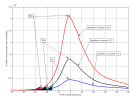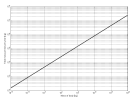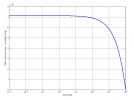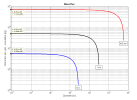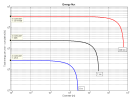tohuwabohu
Jedi Master
Now that the true flux is known we can have a look at how it compares with the impact curve. Note that the impact curve depends on the density distribution function and on the minimal size of the observed objects. So these parameters can be modified when trying to make a fit.
After few hours of trying it became obvious I could not do it. If you look at the histogram in Fig. 31 – the one constructed from the AMS data, you can notice that there are two distinct slopes in it. The first is spanning the years 2005 to 2010 and the second is from 2010 to 2013. Well there is also third slope for years 2013 and 2014 but I found that this slope corresponds to constant density profile.
As you can see I could make a perfect fit with the first one and the impact curve albeit I had to push it a little bit to the right (closer to perihelion) and increase the logarithmic exponent to -4.9 (Fig. 32). This is the lower bound that was clearly defined because for smaller exponents (in absolute terms, meaning closer to zero) the error of the fit started to rise dramatically.
For this fit our position is 15 years before perihelion so in other words if it were true then the companion would reach perihelion in year 2030. The number of fireballs at maximum near perihelion would be 5 times higher compared to what it is today.
After few hours of trying it became obvious I could not do it. If you look at the histogram in Fig. 31 – the one constructed from the AMS data, you can notice that there are two distinct slopes in it. The first is spanning the years 2005 to 2010 and the second is from 2010 to 2013. Well there is also third slope for years 2013 and 2014 but I found that this slope corresponds to constant density profile.
As you can see I could make a perfect fit with the first one and the impact curve albeit I had to push it a little bit to the right (closer to perihelion) and increase the logarithmic exponent to -4.9 (Fig. 32). This is the lower bound that was clearly defined because for smaller exponents (in absolute terms, meaning closer to zero) the error of the fit started to rise dramatically.
For this fit our position is 15 years before perihelion so in other words if it were true then the companion would reach perihelion in year 2030. The number of fireballs at maximum near perihelion would be 5 times higher compared to what it is today.



